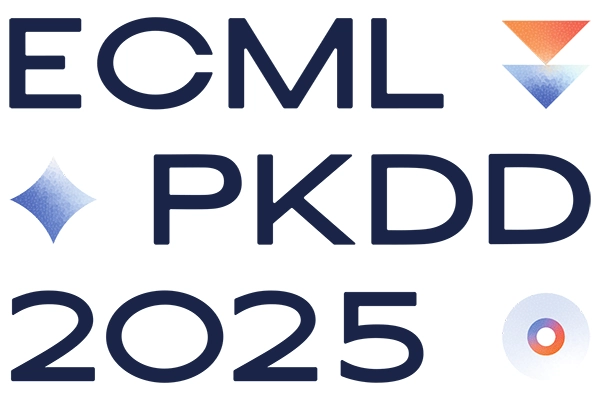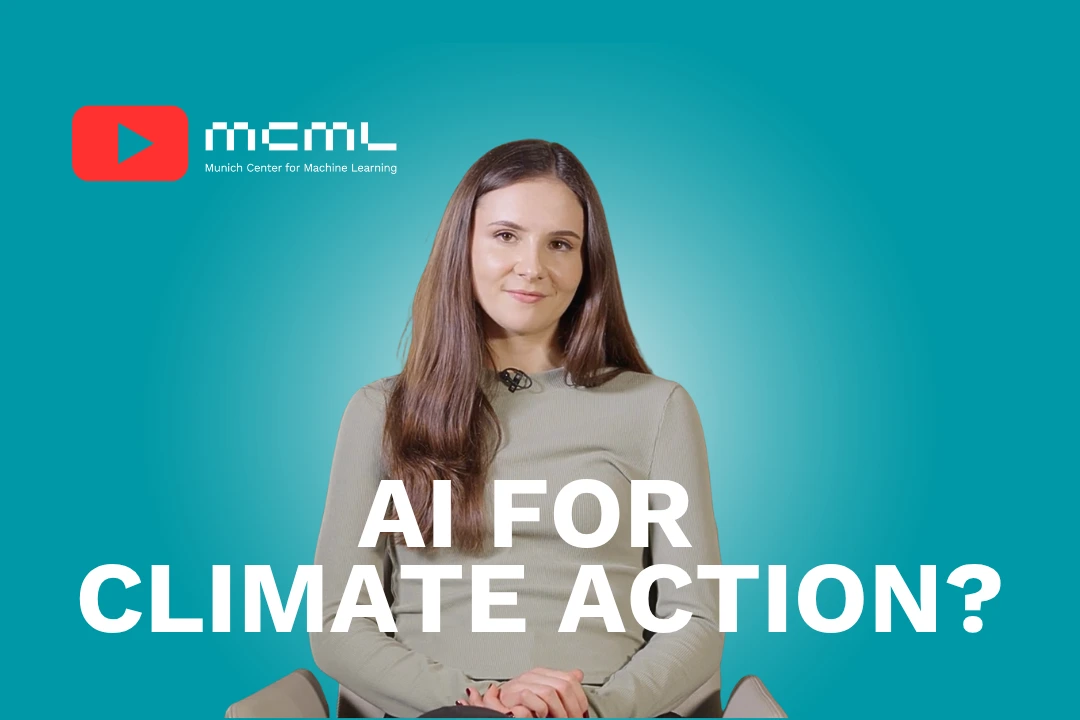12.09.2025

MCML Researchers With Nine Papers at ECML-PKDD 2025
European Conference on Machine Learning and Principles and Practice of Knowledge Discovery in Database (ECML-PKDD 2025). Porto, Portugal, 15.09.2025–19.09.2025
We are happy to announce that MCML researchers are represented with nine papers at ECML-PKDD 2025. Congrats to our researchers!
Main Track (6 papers)
Distribution Matching for Graph Quantification under Structural Covariate Shift.
ECML-PKDD 2025 - European Conference on Machine Learning and Principles and Practice of Knowledge Discovery in Databases . Porto, Portugal, Sep 15-19, 2025. To be published. Preprint available. PDF
Abstract
Graphs are commonly used in machine learning to model relationships between instances. Consider the task of predicting the political preferences of users in a social network; to solve this task one should consider, both, the features of each individual user and the relationships between them. However, oftentimes one is not interested in the label of a single instance but rather in the distribution of labels over a set of instances; eg, when predicting the political preferences of users, the overall prevalence of a given opinion might be of higher interest than the opinion of a specific person. This label prevalence estimation task is commonly referred to as quantification learning (QL). Current QL methods for tabular data are typically based on the so-called prior probability shift (PPS) assumption which states that the label-conditional instance distributions should remain equal across the training and test data. In the graph setting, PPS generally does not hold if the shift between training and test data is structural, ie, if the training data comes from a different region of the graph than the test data. To address such structural shifts, an importance sampling variant of the popular adjusted count quantification approach has previously been proposed. In this work, we extend the idea of structural importance sampling to the state-of-the-art KDEy quantification approach. We show that our proposed method adapts to structural shifts and outperforms standard quantification approaches.
MCML Authors
Decomposing Global Feature Effects Based on Feature Interactions.
ECML-PKDD 2025 - Nectar Track at European Conference on Machine Learning and Principles and Practice of Knowledge Discovery in Databases . Porto, Portugal, Sep 15-19, 2025. To be published. Preprint available. arXiv
Abstract
Global feature effect methods, such as partial dependence plots, provide an intelligible visualization of the expected marginal feature effect. However, such global feature effect methods can be misleading, as they do not represent local feature effects of single observations well when feature interactions are present. We formally introduce generalized additive decomposition of global effects (GADGET), which is a new framework based on recursive partitioning to find interpretable regions in the feature space such that the interaction-related heterogeneity of local feature effects is minimized. We provide a mathematical foundation of the framework and show that it is applicable to the most popular methods to visualize marginal feature effects, namely partial dependence, accumulated local effects, and Shapley additive explanations (SHAP) dependence. Furthermore, we introduce and validate a new permutation-based interaction detection procedure that is applicable to any feature effect method that fits into our proposed framework. We empirically evaluate the theoretical characteristics of the proposed methods based on various feature effect methods in different experimental settings. Moreover, we apply our introduced methodology to three real-world examples to showcase their usefulness.
MCML Authors

Julia Herbinger
Dr.
* Former Member
Going Offline: An Evaluation of the Offline Phase in Stream Clustering.
ECML-PKDD 2025 - European Conference on Machine Learning and Principles and Practice of Knowledge Discovery in Databases . Porto, Portugal, Sep 15-19, 2025. To be published. Preprint available. PDF GitHub
Abstract
Data streams are a challenging and ever more relevant setting for clustering methods as more data arrives faster and faster. Stream clustering strategies either determine the clusters in an online manner directly as the instances appear, or they employ an offline phase where the online summarization structures are processed to obtain a clustering result. A recent analysis found that offline clustering may often be unnecessary or even counterproductive. The methods used in the offline phase are usually fixed for each stream clustering approach and typically stem from only a handful of clustering techniques. In this paper, we perform a broad experimental analysis specifically targeting the offline phase of stream clustering. We analyze several ways of extracting information from the summarization structures, including a novel strategy
based on data generation. Ultimately, we showcase that an offline phase is an impactful design choice for stream clustering. We also find that the chosen offline method significantly impacts the clustering performance, with the clustering quality improving drastically for some settings.
MCML Authors
On Training Survival Models with Scoring Rules.
ECML-PKDD 2025 - European Conference on Machine Learning and Principles and Practice of Knowledge Discovery in Databases . Porto, Portugal, Sep 15-19, 2025. To be published. Preprint available. arXiv
Abstract
Survival Analysis provides critical insights for partially incomplete time-to-event data in various domains. It is also an important example of probabilistic machine learning. The probabilistic nature of the predictions can be exploited by using (proper) scoring rules in the model fitting process instead of likelihood-based optimization. Our proposal does so in a generic manner and can be used for a variety of model classes. We establish different parametric and non-parametric sub-frameworks that allow different degrees of flexibility. Incorporated into neural networks, it leads to a computationally efficient and scalable optimization routine, yielding state-of-the-art predictive performance. Finally, we show that using our framework, we can recover various parametric models and demonstrate that optimization works equally well when compared to likelihood-based methods.
MCML Authors
Enhancing Traffic Accident Classifications: Application of NLP Methods for City Safety.
ECML-PKDD 2025 - European Conference on Machine Learning and Principles and Practice of Knowledge Discovery in Databases . Porto, Portugal, Sep 15-19, 2025. To be published. Preprint available. arXiv
Abstract
A comprehensive understanding of traffic accidents is essential for improving city safety and informing policy decisions. In this study, we analyze traffic incidents in Munich to identify patterns and characteristics that distinguish different types of accidents. The dataset consists of both structured tabular features, such as location, time, and weather conditions, as well as unstructured free-text descriptions detailing the circumstances of each accident. Each incident is categorized into one of seven predefined classes. To assess the reliability of these labels, we apply NLP methods, including topic modeling and few-shot learning, which reveal inconsistencies in the labeling process. These findings highlight potential ambiguities in accident classification and motivate a refined predictive approach. Building on these insights, we develop a classification model that achieves high accuracy in assigning accidents to their respective categories. Our results demonstrate that textual descriptions contain the most informative features for classification, while the inclusion of tabular data provides only marginal improvements. These findings emphasize the critical role of free-text data in accident analysis and highlight the potential of transformer-based models in improving classification reliability.
MCML Authors
Explaining Bayesian Optimization by Shapley Values Facilitates Human-AI Collaboration For Exosuit Personalization.
ECML-PKDD 2025 - European Conference on Machine Learning and Principles and Practice of Knowledge Discovery in Databases . Porto, Portugal, Sep 15-19, 2025. To be published. Preprint available. PDF
Abstract
Bayesian optimization (BO) has become indispensable for black box optimization. However, BO is often considered a black box itself, lacking transparency in the rationale behind proposed parameters. This is particularly relevant in human-in-the-loop applications like personalization of wearable robotic devices. We address BO’s opacity by proposing ShapleyBO, a framework for interpreting BO proposals by game-theoretic Shapley values. Our approach quantifies the contribution of each parameter to BO’s acquisition function (AF). By leveraging the linearity of Shapley values, ShapleyBO can identify the influence of each parameter on BO’s exploration and exploitation behaviors. Our method gives rise to a ShapleyBO-assistedhuman-machineinterface(HMI),allowing users to interfere with BO in case proposals do not align with human reasoning. We demonstrate these HMI’s benefits for the use case of personalizing wearable robotic devices (assistive back exosuits) by human-in-the-loop BO. Results suggest that human-BO teams with access to ShapleyBO outperform teams without access to ShapleyBO.
MCML Authors

Julia Herbinger
Dr.
* Former Member
Workshops (3 papers)
A Guide to Feature Importance Methods for Scientific Inference.
Nectar Track @ECML-PKDD 2025 - Nectar Track at European Conference on Machine Learning and Principles and Practice of Knowledge Discovery in Databases . Porto, Portugal, Sep 15-19, 2025. To be published. Preprint available. arXiv
Abstract
While machine learning (ML) models are increasingly used due to their high predictive power, their use in understanding the data-generating process (DGP) is limited. Understanding the DGP requires insights into feature-target associations, which many ML models cannot directly provide due to their opaque internal mechanisms. Feature importance (FI) methods provide useful insights into the DGP under certain conditions. Since the results of different FI methods have different interpretations, selecting the correct FI method for a concrete use case is crucial and still requires expert knowledge. This paper serves as a comprehensive guide to help understand the different interpretations of global FI methods. Through an extensive review of FI methods and providing new proofs regarding their interpretation, we facilitate a thorough understanding of these methods and formulate concrete recommendations for scientific inference. We conclude by discussing options for FI uncertainty estimation and point to directions for future research aiming at full statistical inference from black-box ML models.
MCML Authors
Distributions over DAGs for Causal Discovery: Limitations of Expressiveness.
MLG @ECML-PKDD 2025 - 22nd International Workshop on Mining and Learning with Graphs at European Conference on Machine Learning and Principles and Practice of Knowledge Discovery in Databases . Porto, Portugal, Sep 15-19, 2025. PDF
Abstract
Bayesian approaches for causal discovery can —inprinciple— quantify uncertainty in the prediction of the underlying causal structure, typically modeled by a directed acyclic graph (DAG). Various semi-implicit models for parametrized distributions over DAGs have been proposed, but their limitations have not been studied thoroughly. In this work, we focus on the expressiveness of parametrized distributions over DAGs in the context of causal discovery. We show several limitations of candidate models in a theoretical analysis and validate them empirically in supervised settings. To overcome these limitations, we propose using mixture models of the considered distributions over DAGs.
MCML Authors
Towards Explainable Deep Clustering for Time Series Data.
TempXAI @ECML-PKDD 2025 - Workshop Explainable AI for Time Series and Data Streams at European Conference on Machine Learning and Principles and Practice of Knowledge Discovery in Databases . Porto, Portugal, Sep 15-19, 2025. To be published.
Abstract
Deepclustering uncovers hidden patterns and groups incomplex time series data, yet its opaque decision-making limits use in safety-critical settings. This survey offers a structured overview of explainable deep clustering for time series, collecting current methods and their realworld applications. We thoroughly discuss and compare peer-reviewed and preprint papers through application domains across healthcare, finance, IoT, and climate science. Our analysis reveals that most work relies on autoencoder and attention architectures, with limited support for streaming, irregularly sampled, or privacy-preserved series, and interpretability is still primarily treated as an add-on. To push the field forward, we outline six research opportunities: (1) combining complex networks with built-in interpretability; (2) setting up clear, faithfulness-focused evaluation metrics for unsupervised explanations; (3) building explainers that adapt to live data streams; (4) crafting explanations tailored to specific domains; (5) adding human-in-the-loop methods that refine clusters and explanations together; and (6) improving our understanding of how time series clustering models work internally. By making interpretability a primary design goal rather than an afterthought, we propose the groundwork for the next generation of trustworthy deep clustering time series analytics.
MCML Authors
Related

29.09.2025
Machine Learning for Climate Action - With Researcher Kerstin Forster
Kerstin Forster researches how AI can cut emissions, boost renewable energy, and drive corporate sustainability.

26.09.2025
Björn Ommer Featured in WELT
MCML PI Björn Ommer told WELT that AI can never be entirely neutral and that human judgment remains essential.

25.09.2025
Björn Schuller Featured in Macwelt Article
MCML PI Björn Schuller discusses in Macwelt how Apple Watch monitors health, detects subtle changes, and supports early intervention.

24.09.2025
MCML PI Björn Ommer Featured on ZDF NANO Talk
MCML PIs Björn Ommer & Alena Buyx discuss AI’s essence on ZDF NANO Talk, covering tech, ethics, and societal impact.















